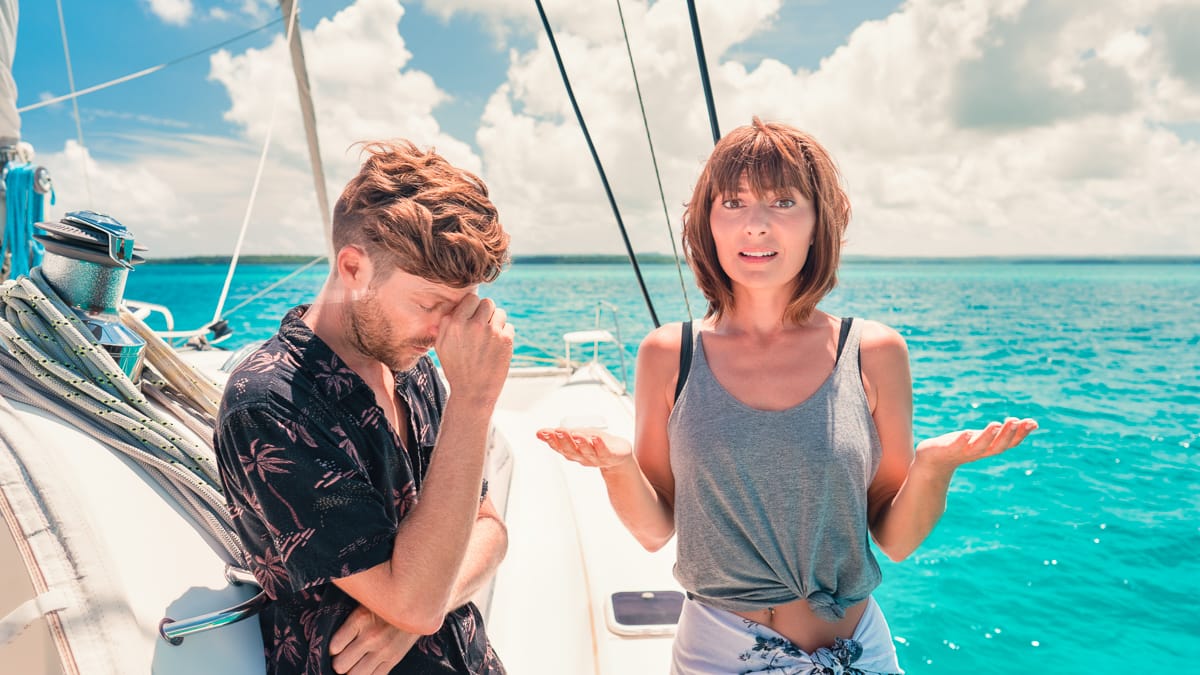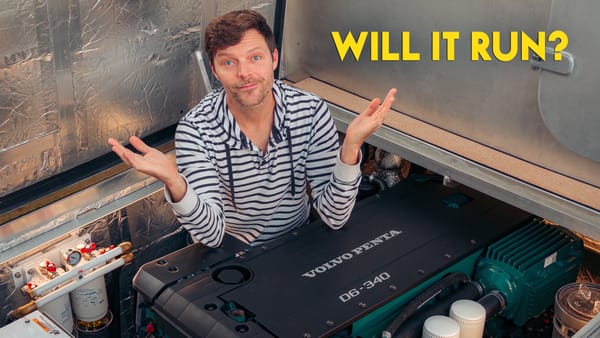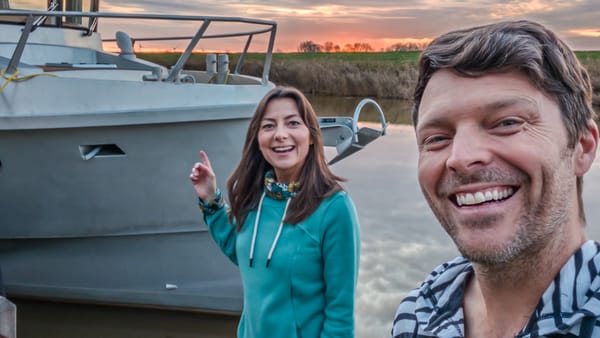How To Make Yacht Insurance Suck Less

We’re starting our 6th year as liveaboard offshore sailors. And without a doubt, yacht insurance has been the most unexpected pain in the arse!
We’d always been told: Getting sailboat insurance the first year would be a challenge. It will be the most expensive for year one because we were newbies…with almost zero sailing experience. But those two warnings were quickly followed up with a little optimism: As you stretch your sea-legs, gain more sailing experience and log more time on the water, options would open up and insurance would get cheaper.
Lies. All Lies.
And it’s not just us, it’s every offshore USA flagged boat owner we talk to. Yacht insurance as an American sailor abroad just kinda sucks. Especially in the South Pacific (for some odd reason). I can’t offer up any words of wisdom on how to fix this mind-bending insurance system, but we have learned a lot on how to best present ourselves and our vessel.
Of course, we are NOT experts and there is still a lot we don’t know. But, if you’re a newbie buying your first boat or a fellow sailor struggling to get offshore, bluewater, around-the-world coverage, hopefully, this information will make the process suck a little less.
Here are the biggest tips we’ve learned about getting boat insurance.
Why is it so difficult to get offshore yacht insurance???
We ask this question to all the insurance brokers we contact and here are some of the responses we’ve received.
- “The current yacht insurance market is getting hard to place coverage for cruisers abroad, and with the majority of the south pacific closed it isn’t very appetizing for US or London Insurers to provide coverage. Inevitably with time, the insurance industry will reopen.”
- “Big, negative changes in the boat insurance markets due to 100,000+ lost vessels in the last 3 years.”
- (increase in natural disasters: hurricanes, floods…)
- “If anyone asks you to sign a Broker of Record Letter, they are trying to get you a quote that I’ve already sent to you…the number of options (or offshore insurance) are narrowing down!”
- Underwriters had a lot of losses in the hurricanes and have really cut down on writing new business that involves long passage making and remote places. If the vessel has a claim, it is hard to find a haul-out, get work done, adjustors, survey, etc.
Why We Need Insurance
Our catamaran is our home, transportation, and everything we own. To us, it’s just not worth risking. In the past, sailors talked about cruising without insurance and how it wasn’t necessary. But the rules are changing. Even in the 5 years, we’ve been sailing we’ve noticed more and more places where sailboat insurance is a requirement. If you plan to sail around the world, here are some of the reasons why you may need yacht insurance.
- Many countries are mandating insurance for entering yachts (Australia, Portugal, and others). And some countries like Panama and Ecuador have required proof of insurance from us when checking into the country.
- Marina’s, Mooring Balls, and Haul Out Yards will require proof of insurance.
- If you have a loan on your vessel, the bank will most likely require insurance.
- Hit and Run Boaters are also a thing. Insurance is expensive and many boaters choose to go without. Imagine when that person accidentally bashes into your boat while you’re on a provision run…it’s not likely they’re going to drop the hook, dinghy over and leave a note on your boat with their contact info. Shoot, even if you see them do it what are the chance you’re going to get money out of them? If you have ‘hit and run’ coverage your insurance company will pay for the repairs.
- Liability! There are a lot of scenarios we could talk about here (dragging anchor, busting off a mooring, hitting a $10,000,000 mega yacht at a fancy marina) and it’s all about what else we could damage that isn’t our boat. If we were to run up a reef, we become responsible for not only the removal and repair of our vessel but any damage to the reef, the property we’re on, and even the government agencies that maintain the oceans/fisheries. Talk about going bankrupt in a hot second!
3 Important Questions To Ask
There is a lot of industry jargon to interpret when it comes to boat insurance. It’s important to do your homework, read the policies, research anything you don’t understand, and ask a lot of questions. Here are some of our standard inquires.
- Is this an ACTUAL CASH value or AGREED AMOUNT value policy? We want Agreed Amount. If the insurance company has agreed to insure our vessel at $300k, then we should receive a payout near that agreed value (not whatever some random computer says the generic value is. We have a lot of upgrades on our boat that the average coastal cruiser or charter boat wouldn’t have).
- Salvage: Who picks up the bill if the boat needs to be salvaged? (from sinking, hurricane damage, etc) When we have a claim, how much help will the insurance company give us? For example, if the boat is damaged in a storm: Who handles the Salvage claims and repair process (find salver, crane, trucking, towing, repair facility, angry property owners, govt. official/agencies). To handle all of this on your own can be EXTREMELY STRESSFUL.
- Consequential Damage: Does the policy have consequential damage coverage: For example what if a corroded through-hull causes the boat to sink (thinking of our single-hulled friends), or a fire breaks out and we don’t have automatic fire suppression in the engine locker (because we don’t)…If we don’t have consequential damage coverage, then a total loss claim could be chalked up to wear and tear.
Terms are Negotiable
Don’t take the initial quote as gospel. Just because a quote comes back with restrictions and requirements doesn’t mean they can’t be negotiated. If you don’t like something, ask about what you can do to change it. Provide additional documentation, upgrade something, take a higher deductible, take a first aid class…ya never know unless you ask.
If the policy says you need to be out of the hurricane zone by June 1st, but your boat isn’t ready to leave, ask for an extension and provide the reasoning. They may give you an extra couple of weeks at no cost. It’s worked for us while we were in Florida.
Crew requirements can be modified. If the underwriter says you need a 4-person crew, resend your sailing resume and plea your case and experience. Explain how your vessel is set up for single-handing, or how you’ve sailed with a smaller crew in more challenging conditions. If it’s compelling, they can make adjustments. We’ve had to do this a couple of times over the years before paying for a new insurance policy,
If a new policy requires a haul-out and survey, but it’s not possible (or cost-prohibitive) to get this at your current location, tell them your intentions are to get a survey once you arrive at the next destination. They may give you 30 or 60 days after arrival to complete it. One of our quotes for 2021 agreed to let us delay the survey until after we arrived in NZ.
Rates We Have Paid
We all like real-world numbers and not hypotheticals. So here is a very quick glance at what we have paid over the past 6 years of being offshore sailors.
Remember, we have had to find a new policy every freaking year. Each year we contact everyone on the list below for quotes, but this year (2021) we hit a new record: The worst quote we’ve ever received at a whopping $11,300 from LJJ (a Lloyds of London underwriter).
We insure our 2005 Leopard 43 Sailing Catamaran at a value of $320,000 usd.
- 2016, Florida/Bahamas: $3860
- 2017, Florida/Bahamas/Panama/Ecuador: $4943
- 2018, Ecuador/ French Polynesia: $4655
- 2019, French Polynesia/Cook Islands/Niue/Tonga: $5517
- 2020, Tonga: $6674
- 2021, Tonga/New Zealand – $4305 (Brokerage: The Marina Shop NZ)
Who To Contact
Yacht Insurance is a complicated world filled with what feels like way too many cooks in the kitchen. There are insurance brokers, insurance companies (including mutual insurance associations), reinsurance companies, and adjusters. To further confuse things, many of the insurance companies are backed by insurance giants like Markel and Lloyd’s of London.
For simplicity’s sake, we’re breaking this up into 2 groups: Yacht Insurance Brokers and Yacht Insurance Companies.
Finding companies that insure US-flagged vessels and provide coverage in our intended cruising area is difficult. One year a company won’t quote us, the next they will. It changes every year and so even if you don’t get a favorable quote one year, try again next year.
Yacht Insurance Brokers
A broker is who we contact to get the quotes and they may work with or submit our information to 1 or 100 different insurance companies to get quotes. We contact at least half a dozen brokers every year for quotes. TIP: If you’ve already received quotes from certain companies, tell the broker in advance so they don’t spend their time getting you exactly the same quotes. Here are the brokers we contact each year. Ask your fellow sailors for their broker information too.
- The Marina Shop (NZ), Contact: Bill Garlick
- International Waters Insurance Services, Contact: Susan Waters
- Novamar Insurance, Contact: Charlie Bailey
- Bailey’s Insurance (NZ), Contact: Ken Monk
- W.R. Hodgens Marine Insurance, Contact: Bill Hodgens
- Global Marine Insurance Agency, Contact: Susan Everhard
Yacht Insurance Companies
This is who is writing and backing the policy (underwriter, reinsurance). Here are the ones we’ve tried with notes on quotes or responses. Your experience with each will no doubt be different.
- Jackline – Will not insure yachts with lithium batteries
- Yachtinsure Limited – Not insuring in the S. Pacific
- Concept – Medium-High quote, loads of restrictions
- LJJ Associates – Highest Quote
- Kemah Marine – High Quote, Few Restrictions
- Admiral Marine – Only insures European vessels
- Chubb Insurance – Cannot quote yachts outside the USA
- Club Marine – Only insures coastal cruising (250 nm from land) in AU, NZ, and TAS
- Pantaenius – High Rate Quotes for the Atlantic & would not quote us for the S. Pacific
- National Specialty Insurance (State National) – Insured us in 2019 & 2020
- Global Yacht Cover – Insured us in 2018
- DUAL Aqua – Insured us in 2017
Sailing Resume, Boat Resume & Maintenance Log
Probably the biggest lesson we’ve learned is to invest time in creating and maintaining a sailing resume, boat resume, and maintenance log. We’ve had multiple insurance brokers compliment us on our approach with these documents and tell us it does make a big difference.
Sailing Resume
Think of it just like a personal job resume. You can even use the free templates online from Microsoft word or whatever program you have. If you want some examples, search for yacht crew resume and you’ll find bunches. But, here is what we have on ours.
- Any professional sailing instruction or certifications (ASA courses). A list or table of the number of days, sizes of vessel, and level of instruction such as basic introduction, skippering training, bareboat charter, off-shore training.
- A good headshot of us at the helm.
- Any safety instruction or certifications. First Aid, First Responder…we even list our PADI open water certification.
- List of boats that you have owned, the type of boat, the size, and for how long.
- All sailing and boating experiences. This will be a list or table of boat length and type (monohull or catamaran), if you were master or crew on the boat and the month/year of the experience. Because we liveaboard we list each month with grand totals for each year.
- We include what country or body of water it was in.
- We note the nautical miles sailed.
- Note if it was a multi-day (list how many days) or overnight passage.
- Special endorsements that you have been given by an instructor (ex: catamaran sailing, engine maintenance, maneuvering and docking, heavy weather, etc.). Letters of recommendations from certified captains can help prove competency.
Boat Resume
I haven’t been able to find any examples online but I think of it much like a for sale listing. Lots of photos (front, sides, back, top-down) and I list out every safety benefit I can muster. We include:
- Year, Make, Builder, Length: 2005 R&C Leopard 43 Sailing Catamaran.
- Home Port, Registration (US Coast Guard), MMSI number, Hull ID number.
- Tender information (and photos): Year, make, construction type, registration, hull ID, engine.
- Description of the boat, how it’s known as a bluewater sailboat built for reliable construction, seaworthiness, and performance. With extra emphasis on reinforced construction, sealed bulkheads, high-quality materials…
- Images of the layout of the boat from the manufacture (scans of original brochure).
- List out all additional upgrades and safety equipment (anything showing redundancy, additional safety, or reliability)
- Details of our sail plans for the year (passage from Tonga to New Zealand, coastal waters of New Zealand)
- Quick List of Crew and experience. The cliff notes version of our sailing resumes.
Maintenance Log
This one is fairly straightforward. We have photos from our haul-outs and list work completed, upgrades, and replacements.
We have our most recent survey and a signed survey compliance list from the yard proving that we completed the tasks mandated by the marine surveyor. But ask your broker before sending this, if your survey is more than 2 years old they may want you to ‘keep it in your pocket’ and only provide it if the underwriter requests it.
We also keep a maintenance log of our engines and routine maintenance. We let the broker know this is available upon request.
Tips To Get The Best Quote
There are a lot of factors that affect boat insurance costs. The age and condition of the vessel, the cruising area, and your experience all matter. But there are a lot of extra details worth considering.
- Select the highest deductible you can afford. Often it’s automatically set at 5%-10% on quotes. If you can afford 15% or 20% it can save a substantial amount each year.
- Umbrella Policy: Insure personal articles through another insurance company like homeowners, renter’s insurance, personal items policy, etc.
- Be realistic with your estimated values and revisit them each year. If similar boats are selling for $100k don’t try to insure your boat for $150k. If you paid $10k for your RIB 5 years ago, consider lowering the estimated value to reflect the market value.
- Limit Emergency Evacuation and Towing benefits. Seek 3rd party companies as they are sometimes less expensive and provide more comprehensive services. For example DAN (Divers Alert Network) or programs like Sea Tow or Boat US. Also, check with your health insurance company about the costs of adding medical evacuation.
- Safety: Upgrade your safety gear like Bilge Pumps, EPRIB, Off-Shore Life vests, Life Raft, Flares, AIS MOB, etc. One insurance company wanted to make sure our vessel had an EXTRA 1500 gph bilge pump that could be easily wired and placed in the bilge for emergencies.
- Cruising Plans: Be realistic with your Cruising Plans and understand the navigational limits. Cruising grounds requested can play a big role in coverage and cost. Some countries are considered safer to visit and cost less to insure. For example, it is possible to sail to Cuba, but many insurance agencies will charge an extra premium because navigation aids aren’t kept up and charts aren’t always accurate, making it more challenging to navigate. You can often add locations mid-policy, sometimes for free, or for way less than adding it to your planned navigation route from the start.
- Stay out of hurricane or cyclone zones when possible.
- Storm Plan: If you boat in a hurricane zone, your insurer may expect you to provide a hurricane plan. If a storm approaches, will you have it stored in a hurricane-proof facility or will you sail it to a safe harbor? How will you secure it? How many anchors & lines do you have, and what thickness? The right answers can affect your rates, maybe even lower them, but be prepared to follow the plan because your coverage may require it.
- Lock up your dinghy, and dinghy engine even on the davits. Lock lockers with valuable items like SCUBA compressors, or expensive toys. Take photos for proof. Many of our policies had notes in the “fine print” saying if a dinghy (or locker) wasn’t locked up, they wouldn’t cover the loss.
- Recent Marine Survey (Less than 3 Years Old, Proves the Age and Condition of the Vessel).
- Install an Automatic Fire Suppression System.
- Enlist more crew for passages.
- Go propane-free.
- Complete higher certifications (such as a Captain’s License).
🙏 THANK YOU!
Ups, downs and all arounds, we share it all. We’re able to do so because people like you show up each week, read, watch, comment, share, shop our gear store, and toss a tip in our production jar. If you like what you see, there are lots of ways you can show your support.
🎥 CAMERA GEAR USED TO FILM THIS VIDEO
🎶 MUSIC IN THIS VIDEO:
- Artist: Corey Barker
- Music Sourced From Filter: http://bit.ly/FilterTheWynns




